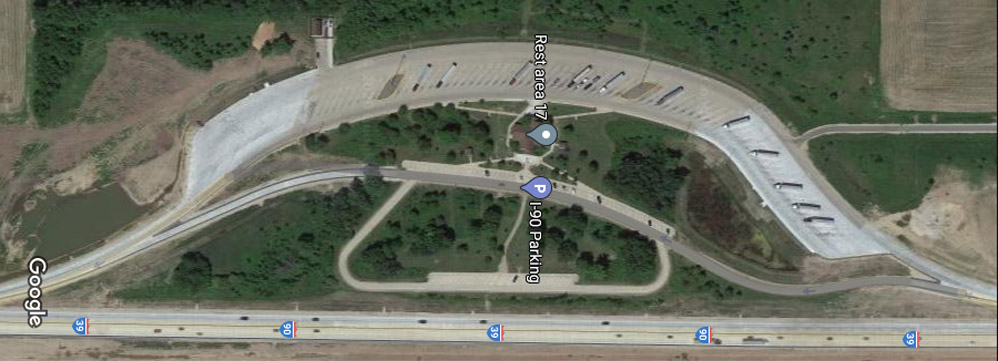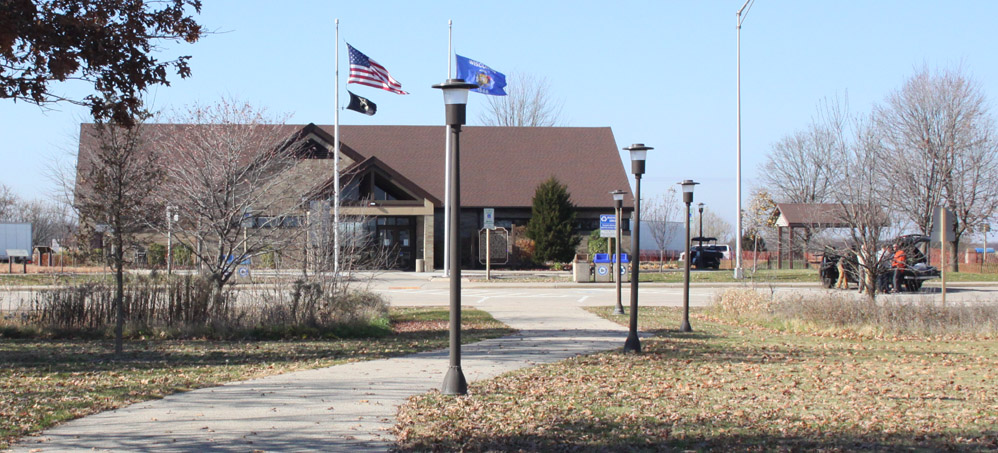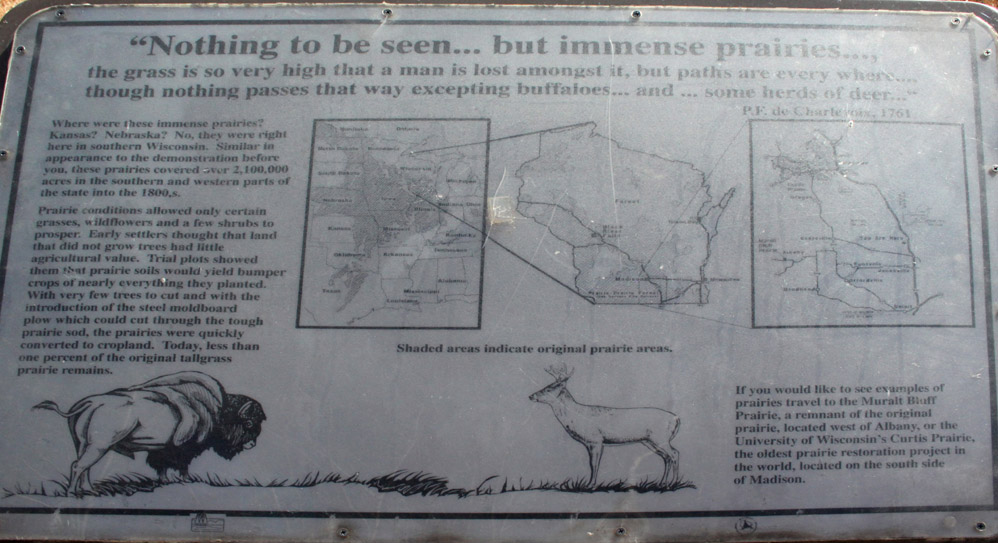
Janesville - Rest
Stop 17
Janesville
is locatedBeloit has a rest area of its own, which is also a welcome center, so it is unusual to find another rest area so close. The only thing I can think is this may be because each of these rest areas only serves traffic going in one direction, and neither has the usual twin area servicing traffic going the other way. At one time, the Janesville stop had a companion stop, rest area 18, servicing northbound traffic, but that area was demolished in 1996, just after this one was updated.
This stop, and its companion stop, were first opened in 1962 during the American boom in highway construction. This stop was enlarged and rebuilt in 1995.
While
most people think of this as a place of woodlands, which
is true enough up north, the southern portion of the
state was originally part of the prairie.

Amenities
- 83 car and 78 truck parking stalls
- Men's and women's restrooms
- Family/assisted restroom
- Handicapped accessible
- Diaper changing facilities
- Drinking water
- Vending machines
- Travel/weather info
- Telephones plus TTY
- Wooded picnic area and tables
- Prairie demonstration plot
- Pet exercise area
- Recycling areas
Features
- Original rest area opened in 1962.
- New building site opened in 1995.
- Old building was in picnic area.
- Companion area 18 northbound closed and demolished in 1996.
- "Rock River Industry" Historical Marker located on site.
This stop
features multiple recycle areas, potable water, a
variety of picnic areas, a place to stretch the legs,
walk the dog, and perhaps enjoy a bit of the Wisconsin
countryside. There are interpretive areas showcasing
some of the history and geography of the area, and
good sized parking areas. There are vending machines,
and clean comfortable rest room. The area is easy on,
and easy off.
Parking
All traffic is one way, entering on the north side of the area and exiting on the south side into southbound traffic. Parking is not allowed for more than 24 hours, and no camping is permitted. Nobody wants tired drivers on the road, so certain allowances are often made, but this is not meant to be a campground. If you unhitch trailers, extend slides, unfurl awnings, or engage in other obviously camping behaviors, you can expect to be approached by the sheriff or state patrol which monitor these areas. A good rule of thumb is no more than
Truck and commercial vehicle drivers have their own parking area off behind the pavilion. The area is quite a bit more private and features 78 large pull though parking spots so that no backing or maneuvering is required. The relative seclusion back here means a more restful and quiet area for truckers to get a bit of sleep.
Truck drivers are also given more leeway in how long they stay, due to regulations in effect that limit how many hours they can drive without rest. Long haul drivers have trucks with their own sleeping and eating facilities, and often bathroom facilities as well, so you are not as likely to see these drivers around the pavilion as you are to see automobile travelers.
Picnic
Picnic areas out here on the road are designed for constant year round use.
Benches are aluminum framed with surfaces molded from composites. There is nothing to rot or rust.
The benches out here are also permanently mounted on concrete aprons, so that they can not be moved, and there is no soft ground underneath to turn to dust or mud. It can also help with insects that might otherwise harass hungry travelers.
The permanent mounts are a good way to insure that the benches can not be moved out into a traffic area where they could pose a considerable hazard. It also prevents theft, which could occur in these relatively isolated areas with no staff on site.Who would steal a picnic bench from a rest area out in the country? Who knows?
These areas are kept well groomed by the grounds staff, largely due to the possibility of biting insects and tic borne diseases, with only a few areas left in a relatively wild state. This creates a number of different styles to suit a variety of tastes.
Special Purpose
In an effort to provide glimpses of local culture, and add a bit of interest, most stops have commemorative or memorial plaques. many have both This particular stop commemorates the early industry of the area and adds a bit of local history.
There is also a memorial dedicated to the Wisconsin veterans of the Civil War. As a general rule, the memorials of each stop are unique to the stop, but the Janesville stop is one of several, part of a series designating this to be part of the Wisconsin Veterans Memorial Highway, which commemorates Wisconsin Civil War veterans.
In addition to memorials and commemoratives, rest areas all feature portions set aside and allowed to grow wild. They generally have what they call demonstration plots, which are planted in a style similar to what grew here before the area was settled and farmed.
Another display indicates the impression that the wide open prairies made upon the explorers and settlers that passed through the area. The display advises that at one time the area abounded with buffalo and elk.
In many ways, these areas are like little miniature parks, complete with picnic areas, interpretive displays, nature exhibits, and a building for shelter.
Pavilion
This particular unit is near enough to the city of Janesville, that it can use city services. It thus has no need of the satellite dish seen on so many rest area roofs. These buildings are all connected to the Wisconsin WISCDOT computer network, and are monitored remotely.
The double layer glass doors at front and rear open on to the more public traveler area adjacent to the freeway, and the more private trucker area towards the back. The sheltered entrances on both offer protection from the elements, and make handy places to park waste cans, local papers, and coupon books. They also make convenient sheltered areas for the few remaining smokers in the world.
This particular pavilion
The single story structure has peaked roofs to shed snow, with louvers to allow for ventilation. The high ceilings mean that warm air can rise to be passed out through the louvers in summer, while it can be brought down by ceiling fans in the winter, making this structure just a bit less dependent upon mechanical heating and cooling than might otherwise be the case.
Initially the Interstate system was meant to be a means of military transit. In this light, it is hard sometimes not to imagine these massive nearly windowless structures as bunkers and command centers. This is particularly striking when looking at the sides of the structure, which have only steel delivery access doors, and a few high vent windows.
Gone too are the recycle areas and the benches that invite the tourist to sit for a while. Commercial drivers have quite a different use for a rest area, and simply need a place to use the rest room, and then perhaps catch an hour or several hours of nap time before continuing on their way..
Inside
This is a mid-size rest area, with a design very similar to those of many others. The interior is inviting enough, and the quality of construction can be best described as 'substantial'. Like all government buildings, cost is no object, but permanence, durability, and ease of maintenance are very important factors indeed.
The interior is somewhat dark, with no windows except at the front and rear where the doors are located. This makes the interior easier to heat and cool, and also cuts down on opportunities for vandalism. The ceilings are high, with exposed rafters and fans. Lighting is indirect from the ceiling. The walls are whitewash, and the floors are dark tile. Everything is made for ease of cleaning and for durability.
Each doorway has a double set of glass doors, with a small vestibule in between. This space makes a wonderful place to welcome hungry, thirsty, or just plain self indulgent travelers, with a selection of vending machines. The vestibules also help with heating and cooling. The rear vestibule features but a single vending machine, and exits out onto the truck parking area behind the pavilion.
Vending machines are expensive as a general rule, with those out on the open the road being particularly so. Even with this though, if you are out in the country, it is nice to have these things available, if a bit pricey. It is comforting to realize that these are here to help support the RAM program. This program works with a number of organizations to provide employment to the disabled. These organizations send cleaners to all of the rest areas,and I have to admit these places are spotless and always in good repair. Those thus employed are happy for the opportunity,whereas a regular cleaning service, or perhaps a group of state employees might be less than thrilled to be sent out into the countryside to clean rest stops.
Gone are rack after rack of local tourist literature. Such things were a big feature of the rest areas of my youth and formed a supply of memories and a sort of a souvenir of a trip. This information is mostly provided on the Internet now, making paper advertisements a bit of a waste of money. Everyone has a smart phone, laptop, computer, tablet or whatever these days. The exception to this new rule is the few visitor center areas located near the state borders.
What remains, in addition to a place to rest and stretch the legs, are a bulletin board, drinking fountains and potable water, a weather station, and two sets of rest rooms. The drinking fountains are closed as of this writing, due to the Covid hysteria, but will eventually re-open. This site is said to have a telephone and TTY, but I was unable to find them, unless they are in one of the private spaces.
There are a couple of private spaces here for staff and maintenance. They contain the building systems, and also the monitoring gear, work areas, and storage for equipment. They are accessed through their own steel doors on the sides of the building. The area is un-staffed, except for visits by cleaning and grounds crews, but all of these areas are regularly patrolled by state and county law enforcement.
These areas are open 24 x 7 x 365, and are always here. They are clean, safe, and comfortable. As with the rest of the pavilion, they are tile, brick, and metal, and easy to clean and to keep clean. There are some small vent windows high up, which offer privacy and resistance to vandalism.
Standard low water use fixtures are used, except for the water saving self contained sinks. Two sets of rest rooms mean that even if one set is being cleaned, another set will be available. Soap dispensers are available, and are air driers and genuine glass mirrors. No paper towels were there on my visit, but the may have something to do with the Coivd scare. Changing stations are featured in all rest rooms.